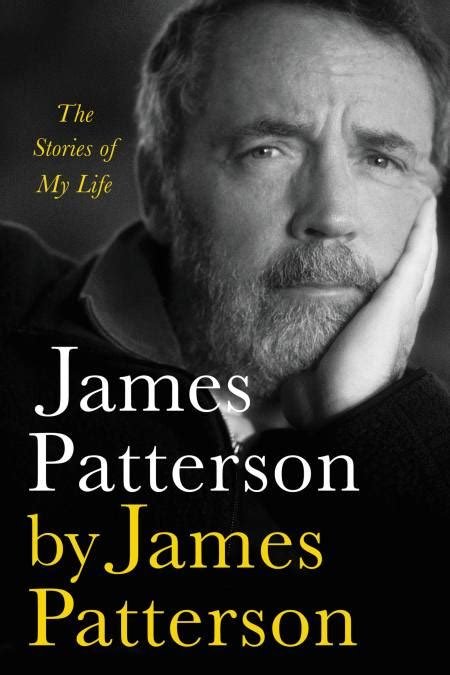By James Patterson
James Patterson is full of stories, but not full of himself. In James Patterson: The Stories of My Life, the famed novelist tells us story after story after story. In listening we learn about his life. What an interesting and delightful read!
What we need to know:
Jame Patterson is passionate about his wife, his son, his craft, and the importance of kids reading. Growing up in Massachusetts, his “summer job” was working at a mental hospital, where he met James Taylor. Patterson was a very successful advertising agent (while pursuing his dream of becoming a writer) and is now the world’s best-selling author. How many times did I read, “I think it may be my best book/favorite book?” He is effusive in his praise for his co-writers, about whom each of them is his “favorite co-writer.”
Think about it:
On the power of story: One thing that I’ve learned and taken to heart about writing books or even delivering a good speech is to tell stories. Story after story after story.
While writing: When I write, I pretend there’s someone sitting across from me—and I don’t want that person to get up until I’m finished with the story.
On Politics and people critical of the “other side”: From what I’ve seen, the problem is folks who believe their view of the world is the right one, the only one, and everybody else’s is flat-out stupid.
Working at writing: He worked at his novel before and after work at J. Walter Thompson North America (80). When the company tripled his meager salary, it was nice but not a game-changer. Patterson writes, “I had no intention of going anywhere. See, I wasn’t really there – I wasn’t an advertising copywriter, I was a novelist in the making. At least in my own mind” (82).
Writers in collaboration: “When people bring up my practice of writing with co-authors, they usually aren’t thinking nice thoughts. Here’s the best defense I’ve come up with about cowriters: Simon & Garfunkel, Lennon & McCartney, Lennon & McCartney & Harrison & Starr, Gilbert & Sullivan, Rodgers & Hammerstein, Woodward & Bernstein, Larry David & Jerry Seinfeld. . . Douglas Preston & Lincoln Child, Joel & Ethan Coen, William Shakespeare & Christopher Marlowe & John Fletcher” (249-50).
Teaching kids to read: "Parents come up to me all the time and say, ‘I can’t get my kids reading.’ I commiserate, then I tell them, ‘Hey, do you manage to get them to the dinner table? Do you allow them to track mud or snow into your living room carpet? Do you let them curse in church?’ Then make this a rule: We read in our house” (241, 262).
The nasty little disease: “I found the Bushes to be down to earth, and they had a terrific sense of humor. When some people get a little too over-the-top negative about Bill and Hillary Clinton, I say to them, ‘You respect the Bushes, right?’ If they’re being honest, most will admit, ‘Yeah, yeah, the Bushes are good people.’ Then I come back with ‘Well, the Bushes love the Clintons. So that’s got to tell you something about the Clintons.’ The two families were especially close, especially President Clinton and 41. It seems to me there’s a nasty little disease going around and it’s especially prevalent on TV and radio new shows. It goes something like this: ‘My view of the world is right – and your view is stupid!’ I really don’t like that. Honestly, it makes me a little sick to my stomach” (196).
On Trump and Clinton playing golf together (which they did): “It’s the way things used to be in politics. Better, saner times” (202).
“The man can write!” (Patterson on Clinton’s speech to his Georgetown classmates): “We can’t give into the current craze to demean and debase, to leave no insult unhurled, no stone unthrown. We just can’t quit or criticize, because we’re old enough to remember another time of great struggle over whether our differences are more important than our coming humanity, whether conflict is more important than cooperation. Whether subtraction and division will chase away our children and grandchildren’s dreams before we rediscover the virtues of addition and multiplication” (200).
Lessons learned:
Outline, outline, outline! Patterson writes a 50-80 page outline for every book. “I write three or four drafts of every outline. I write with a pencil. I like being able to erase things and I’m pretty good at admitting when I make a mistake” (181). In a similar vein, when talking with children, the lesson he gives them is outline:
“Listen! Shush! Shush! Eyes to the front. Ears to the sides. There’s one word I want you to memorize today. Just one word. This one word will make school so much easier, and so much more fun. Are you ready? Who’s ready? I’m ready. Outline, babies! Outline, outline, outline! Outline your book reports, outline any speech you have to make in school, outline your e-mails, outline the text you sent to your friends” (242).
Utilize the power of story in writing history: Seems simple, but it is how Patterson writes his non-fiction: “I just tell stories, and I don’t even have to make anything up. Almost seems too easy” (234).
Dad stories: Patterson and his dad hugged and said, “I love you” to each other for the first time in his father’s hospital room, a week before his father died. “Charles and James. After all those years, we finally came together. Less than a week later, he was gone. Here’s what I took away from those last few days, the lesson I learned and took to heart. From the time Jack (his son) was a little kid until now, every single night before he goes to bed, I go into his room and give him a big hug. I tell Jack that I love him, and he tells me that he loves me back” (272).
Collaboration: Use his “reason” for collaboration in my work, Playing Second Fiddle.
Books to Read: See pages 350-352 for his list
The Seven Story Mountain by Thomas Merton
People Will Always Be Kind by Wilfrid Sheed
Walk In My Combat Boots by James Patterson, Matt Eversmann et al
Mrs. Bridge by Evan Connell Jr. (the novel that influenced his writing style the most)
Steps and The Painted Bird by Jerzy Kosinki
Words to ponder:
On Critics: Asking a working writer how he feels about critics is like asking a lamppost what it feels about dogs (English playwright John Osborne, 249).
On marriage to Sue, his wife: “To be honest, every once in a while, there’s an hour or two when I can’t stand Sue—but there isn’t a day that goes by that I’m not in love with her” (291).
A great T-shirt: A couple of my old friends kept playing basketball well into their fifties. They were in a men’s league with mostly younger guys. My friends weren’t all that good anymore, but they had the best team T-shirts in the league. The shirts said, “NOBODY MOVES, NOBODY GETS HURT” (266).
Red Smith on Writing: “Writing is easy. You just open a vein and bleed” (Red Smith, Sportswriter, 330).
Dorothy Sayers on Writing: “If you have any young friends who aspire to become writers, the second greatest favor you can do them is to present them with copies of The Elements of Style. The first greatest, of course, is to shoot them now, while they’re happy” (330).
Woody Allen on writing: "Lay your proboscis on the grindstone. Don't look up. Work. Enjoy the work. If you don't enjoy the work, change occupations" (331).
recommendation:
My wife bought this book for me for my birthday. I picked it up yesterday, I finished it today. It’s five stars for the candid picture of a great writer, the insights, the fast-pace, the humility, and yes, the stories.


